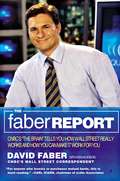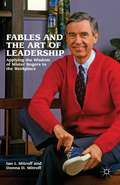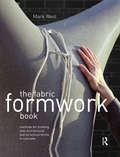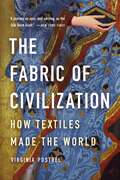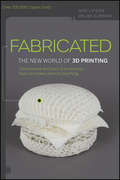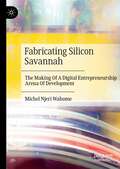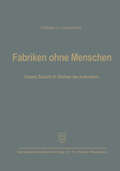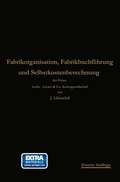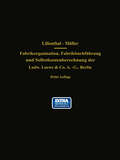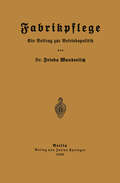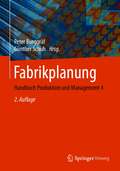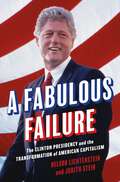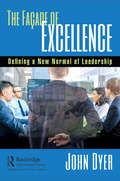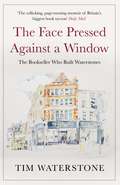- Table View
- List View
The Faber Report: CNBC's "The Brain" Tells You How Wall Street Really Works and How You Can Make It Work for You
by Ken Kurson David FaberThese days, when CNBC's David Faber talks, Wall Street listens. Unlike the talking heads that populate the financial news channels, Faber is a down-and-dirty investigative reporter. For six years, on CNBC's popular Squawk Box and in his own segments, Faber has broken story after story. Each day over one million people tune in to hear his daily report. Those who know the score know that Faber is the one to listen to -- especially now that the market isn't doing as well as it used to. Now Faber has written the smartest, most innovative investment book to be published in years. Like Harvard Business School's famous case study method, each chapter is built around a story -- the story of how a stock was presented to the public. Then Faber extracts clear, easy-to-follow lessons and instructions on how readers can learn the stocks real story, just as he does everyday on CNBC. Readers learn not just how to pick the stocks they want to invest in, but how to avoid joining the "penguins" lining up for big losses. The Faber Report combines practical, down to earth investment advice with wild accounts of investor fraud, company misdeeds, and famous investors and banks that have led investors astray. A quantum leap beyond the usual investment books, The Faber Report is essential reading for anyone who wants to profit-bulls or bears.
The Fable of the Keiretsu: Urban Legends of the Japanese Economy
by Yoshiro Miwa J. Mark RamseyerFor Western economists and journalists, the most distinctive facet of the post-war Japanese business world has been the keiretsu, or the insular business alliances among powerful corporations. Within keiretsu groups, argue these observers, firms preferentially trade, lend money, take and receive technical and financial assistance, and cement their ties through cross-shareholding agreements. In The Fable of the Keiretsu, Yoshiro Miwa and J. Mark Ramseyer demonstrate that all this talk is really just urban legend. In their insightful analysis, the authors show that the very idea of the keiretsu was created and propagated by Marxist scholars in post-war Japan. Western scholars merely repatriated the legend to show the culturally contingent nature of modern economic analysis. Laying waste to the notion of keiretsu, the authors debunk several related “facts” as well: that Japanese firms maintain special arrangements with a “main bank,” that firms are systematically poorly managed, and that the Japanese government guided post-war growth. In demolishing these long-held assumptions, they offer one of the few reliable chronicles of the realities of Japanese business.
The Fable of the Keiretsu: Urban Legends of the Japanese Economy
by Yoshiro Miwa J. Mark RamseyerFor Western economists and journalists, the most distinctive facet of the post-war Japanese business world has been the keiretsu, or the insular business alliances among powerful corporations. Within keiretsu groups, argue these observers, firms preferentially trade, lend money, take and receive technical and financial assistance, and cement their ties through cross-shareholding agreements. In The Fable of the Keiretsu, Yoshiro Miwa and J. Mark Ramseyer demonstrate that all this talk is really just urban legend. In their insightful analysis, the authors show that the very idea of the keiretsu was created and propagated by Marxist scholars in post-war Japan. Western scholars merely repatriated the legend to show the culturally contingent nature of modern economic analysis. Laying waste to the notion of keiretsu, the authors debunk several related “facts” as well: that Japanese firms maintain special arrangements with a “main bank,” that firms are systematically poorly managed, and that the Japanese government guided post-war growth. In demolishing these long-held assumptions, they offer one of the few reliable chronicles of the realities of Japanese business.
Fables and the Art of Leadership: Applying the Wisdom of Mister Rogers to the Workplace
by Ian I. Mitroff Donna MitroffFred Rogers is one of the great icons of American culture and the values and philosophy for which he is famous have stood the test of time. Fables and the Art of Leadership brings those same values and philosophy to the workplace, where they're now needed more than ever. This unique and timely work is for everyone who aspires to become and be a better leader. Mister Rogers didn't expound abstract principles to help children face up to the problems they faced; instead, he created and told countless fables and stories. Ian and Donna Mitroff's book uses those fables to help managers master the most difficult challenges they face: achieving significant change; fostering creativity; curbing rudeness; promoting leadership, managing crises, and many more. It is their new interpretations for the workplace that will make Fables and the Art of Leadership a classic in business studies.
The Fabric Formwork Book: Methods for Building New Architectural and Structural Forms in Concrete
by Mark WestConcrete is the most used man-made material in the world and is the fundamental physical medium for most of the world’s architecture and construction. The character of concrete is largely the product of the rigid moulds that have shaped it since its invention in antiquity. The advent of flexible moulds, however, marks a radical break from conventional practice – and conventional concrete architecture. The Fabric Formwork Book provides the first comprehensive handbook on the emerging technology of flexible moulds for reinforced concrete architecture. Written by the foremost expert in the field, this book takes a comprehensive and generous approach that includes technical, historical and theoretical aspects of the subject. The book: concentrates on simple flat-sheet formworks contains detailed technical descriptions of how to construct a wide range of formworks for various applications features case studies from around the world critiques the difficulties and advantages in each case it covers provides instruction and guidance on how to model and design fabric-formed structures includes the most comprehensive history of fabric formwork yet published features essays from guest expert authors, which explore the theoretical, historical, and poetic significance of flexibly formed architecture and structures discusses fabric formwork as an exemplary approach to sustainable construction through its simplicity and efficiency. Beautifully designed and illustrated with a superb range of images, diagrams and technical drawings, the book both informs and inspires. Speaking directly and plainly to professionals, students and academics, the language used is both clear and precise, and care is taken to avoid opaque technical or academic jargon. Technical terms, when used, are clearly described and a special glossary is included to make the book as widely accessible as possible.
The Fabric Formwork Book: Methods for Building New Architectural and Structural Forms in Concrete
by Mark WestConcrete is the most used man-made material in the world and is the fundamental physical medium for most of the world’s architecture and construction. The character of concrete is largely the product of the rigid moulds that have shaped it since its invention in antiquity. The advent of flexible moulds, however, marks a radical break from conventional practice – and conventional concrete architecture. The Fabric Formwork Book provides the first comprehensive handbook on the emerging technology of flexible moulds for reinforced concrete architecture. Written by the foremost expert in the field, this book takes a comprehensive and generous approach that includes technical, historical and theoretical aspects of the subject. The book: concentrates on simple flat-sheet formworks contains detailed technical descriptions of how to construct a wide range of formworks for various applications features case studies from around the world critiques the difficulties and advantages in each case it covers provides instruction and guidance on how to model and design fabric-formed structures includes the most comprehensive history of fabric formwork yet published features essays from guest expert authors, which explore the theoretical, historical, and poetic significance of flexibly formed architecture and structures discusses fabric formwork as an exemplary approach to sustainable construction through its simplicity and efficiency. Beautifully designed and illustrated with a superb range of images, diagrams and technical drawings, the book both informs and inspires. Speaking directly and plainly to professionals, students and academics, the language used is both clear and precise, and care is taken to avoid opaque technical or academic jargon. Technical terms, when used, are clearly described and a special glossary is included to make the book as widely accessible as possible.
The Fabric of Civilization: How Textiles Made the World
by Virginia PostrelFrom Paleolithic flax to 3D knitting, explore the global history of textiles and the world they weave together in this enthralling and educational guide.The story of humanity is the story of textiles -- as old as civilization itself. Since the first thread was spun, the need for textiles has driven technology, business, politics, and culture.In The Fabric of Civilization, Virginia Postrel synthesizes groundbreaking research from archaeology, economics, and science to reveal a surprising history. From Minoans exporting wool colored with precious purple dye to Egypt, to Romans arrayed in costly Chinese silk, the cloth trade paved the crossroads of the ancient world. Textiles funded the Renaissance and the Mughal Empire; they gave us banks and bookkeeping, Michelangelo's David and the Taj Mahal. The cloth business spread the alphabet and arithmetic, propelled chemical research, and taught people to think in binary code.Assiduously researched and deftly narrated, The Fabric of Civilization tells the story of the world's most influential commodity.
Fabricated: The New World of 3D Printing
by Hod Lipson Melba KurmanFabricated tells the story of 3D printers, humble manufacturing machines that are bursting out of the factory and into schools, kitchens, hospitals, even onto the fashion catwalk. Fabricated describes our emerging world of printable products, where people design and 3D print their own creations as easily as they edit an online document. A 3D printer transforms digital information into a physical object by carrying out instructions from an electronic design file, or 'blueprint.' Guided by a design file, a 3D printer lays down layer after layer of a raw material to 'print' out an object. That's not the whole story, however. The magic happens when you plug a 3D printer into today’s mind-boggling digital technologies. Add to that the Internet, tiny, low cost electronic circuitry, radical advances in materials science and biotech and voila! The result is an explosion of technological and social innovation. Fabricated takes the reader onto a rich and fulfilling journey that explores how 3D printing is poised to impact nearly every part of our lives. Aimed at people who enjoy books on business strategy, popular science and novel technology, Fabricated will provide readers with practical and imaginative insights to the question 'how will this technology change my life?' Based on hundreds of hours of research and dozens of interviews with experts from a broad range of industries, Fabricated offers readers an informative, engaging and fast-paced introduction to 3D printing now and in the future.
Fabricated: The New World of 3D Printing
by Hod Lipson Melba KurmanFabricated tells the story of 3D printers, humble manufacturing machines that are bursting out of the factory and into schools, kitchens, hospitals, even onto the fashion catwalk. Fabricated describes our emerging world of printable products, where people design and 3D print their own creations as easily as they edit an online document. A 3D printer transforms digital information into a physical object by carrying out instructions from an electronic design file, or 'blueprint.' Guided by a design file, a 3D printer lays down layer after layer of a raw material to 'print' out an object. That's not the whole story, however. The magic happens when you plug a 3D printer into today’s mind-boggling digital technologies. Add to that the Internet, tiny, low cost electronic circuitry, radical advances in materials science and biotech and voila! The result is an explosion of technological and social innovation. Fabricated takes the reader onto a rich and fulfilling journey that explores how 3D printing is poised to impact nearly every part of our lives. Aimed at people who enjoy books on business strategy, popular science and novel technology, Fabricated will provide readers with practical and imaginative insights to the question 'how will this technology change my life?' Based on hundreds of hours of research and dozens of interviews with experts from a broad range of industries, Fabricated offers readers an informative, engaging and fast-paced introduction to 3D printing now and in the future.
Fabricating Silicon Savannah: The Making Of A Digital Entrepreneurship Arena Of Development
by Michel Njeri WahomeThis book provides a comprehensive overview of technology start-up arenas in Nairobi and examines their global place. These start-ups are popularly perceived as representing future prosperity that is incorporated in the present. The author examines how developing country arenas lay bare the power asymmetries and taken-for-granted assumptions that determine which technoscientific imaginaries become globalized and universal, and are supported by legitimizing narratives, logics and institutions. A framing of ‘catch-up’ or ‘leapfrogging’ for technoscientific development that is based on capitalist modernity is regarded as incontrovertible—so much so that alternative values and approaches to technology production are rarely contemplated. This book documents how actors in Nairobi’s startup arena relate to these imaginaries and the affects, enactments and places that they produce.
Fabrikbetriebslehre 1: Management in der Produktion
by Thomas BauernhanslDie industrielle Produktion ist für Volkswirtschaften von herausragender Bedeutung. Neben der Schaffung von Arbeitsplätzen bilden vor allem ihre Beiträge zu Export, Wachstum und Innovation die Grundlage für den ökonomischen Erfolg. Volkswirtschaften, wie auch Deutschland, profitieren zudem langfristig von ihrem hohen Industrieanteil, insbesondere in Krisenzeiten. Dennoch steht die Industrie vor entscheidenden Herausforderungen. Diese sind u.a. die Reduktion der Umweltwirkung bei gleichzeitiger Steigerung der Produktivität, die Förderung qualifizierter Mitarbeiter vor dem Hintergrund des zu erwartenden Fachkräftemangels sowie die Digitalisierung.Das vorliegende Lehrbuch führt in die Organisation und Funktionen einer Fabrik ein. Es vermittelt die Grundlagen des Fabrikbetriebs mit Blick auf ihre praktische Anwendung: Die ersten drei Kapitel beschreiben die Produktion im volks- und betriebswirtschaftlichen Kontext, die Unternehmensstrategien und -strukturen sowie die Innovationsprozesse und die Produktentwicklung. In den Folgekapiteln werden die charakteristischen Aspekte und Methoden des Fabrikbetriebs anhand eines systemischen Wertschöpfungsmodells erläutert.
Fabriken ohne Menschen: Unsere Zukunft im Zeichen der Automation
by Louis EmrichIm Frühsommer 1956 erhielt ich von der Generaldirektion eines westdeutschen Großunternehmens den Auftrag, ein Gutachten dar über auszuarbeiten, welche Vorteile die Einführung der Automation gegenüber der herkömmlichen Produktionsweise ergibt. Bei der Ausarbeitung dieses Gutachtens stieß ich auf so viele völlig neue Momente, welche die Automation generell offenbart, daß ich mich entschloß, über das Gesamtproblem eine richtungweisende Broschüre zu schreiben. Aus der Broschüre wurde zuletzt das vorliegende Buch, das erste in deutscher Sprache, in welchem der Problemkomplex der Automation nicht nur bis zur Gegenwart, sondern auch in ihren grundlegenden zukünftigen Aspekten behandelt ist. Die Automation ist ja selbst vorausgegriffene Zukunft! Alles, was heute geplant, gebaut, gelehrt und investiert wird, gilt der Zukunft. Jeder Plan, der aufgestellt, jeder Bau, der errichtet, jede neue These, die vertreten, und jeder Betrag, der für Neuanlagen und Erhöhung der Produktion ausgegeben wird, gilt der Entwicklung von morgen, gilt den kommenden Jahren und Jahrzehnten. Nichts belegt diese Auffassung eindeutiger als die Tatsache, daß zur Zeit nicht weniger als über eine Million Wissenschaftler damit be schäftigt sind, Fragen zu studieren und Aufgaben zu lösen, die aus schließlich der Zukunft gelten. Allein in den USA stehen hinter den neuen Produkten, die morgen auf der Basis der Automation auf den Markt kommen, und hinter den Studien und Forschungsplätzen, die geschaffen wurden, um die Massenproduktion von morgen auch reibungslos abzusetzen, über 300 000 Forscher aller Wissenszweige.
Fabrikorganisation, Fabrikbuchführung und Selbstkostenberechnung
by Johann Lilienthal Georg SchlesingerDieser Buchtitel ist Teil des Digitalisierungsprojekts Springer Book Archives mit Publikationen, die seit den Anfängen des Verlags von 1842 erschienen sind. Der Verlag stellt mit diesem Archiv Quellen für die historische wie auch die disziplingeschichtliche Forschung zur Verfügung, die jeweils im historischen Kontext betrachtet werden müssen. Dieser Titel erschien in der Zeit vor 1945 und wird daher in seiner zeittypischen politisch-ideologischen Ausrichtung vom Verlag nicht beworben.
Fabrikorganisation, Fabrikbuchführung und Selbstkostenberechnung der Ludw. Loewe & Co. A.-G., Berlin: Mit Genehmigung der Direktion zusammengestellt und erläutert
by J. Lilienthal G. Schlesinger Wilhelm MüllerDieser Buchtitel ist Teil des Digitalisierungsprojekts Springer Book Archives mit Publikationen, die seit den Anfängen des Verlags von 1842 erschienen sind. Der Verlag stellt mit diesem Archiv Quellen für die historische wie auch die disziplingeschichtliche Forschung zur Verfügung, die jeweils im historischen Kontext betrachtet werden müssen. Dieser Titel erschien in der Zeit vor 1945 und wird daher in seiner zeittypischen politisch-ideologischen Ausrichtung vom Verlag nicht beworben.
Fabrikpflege: Ein Beitrag zur Betriebspolitik
by Frieda WunderlichDieser Buchtitel ist Teil des Digitalisierungsprojekts Springer Book Archives mit Publikationen, die seit den Anfängen des Verlags von 1842 erschienen sind. Der Verlag stellt mit diesem Archiv Quellen für die historische wie auch die disziplingeschichtliche Forschung zur Verfügung, die jeweils im historischen Kontext betrachtet werden müssen. Dieser Titel erschien in der Zeit vor 1945 und wird daher in seiner zeittypischen politisch-ideologischen Ausrichtung vom Verlag nicht beworben.
Fabrikplanung: Handbuch Produktion und Management 4
by Peter Burggräf Günther SchuhDas mehrbändige Handbuch "Produktion und Management" richtet sich an Fach- und Führungskräfte technologieorientierter Unternehmen, die nach methodischer Unterstützung suchen, ebenso wie an Wissenschaftler und Studenten der Ingenieurwissenschaften und der Betriebswirtschaftslehre.Der Band Fabrikplanung behandelt diese als einen modularen Prozess. Die frei konfigurierbaren Planungsmodule ermöglichen die individuelle Anpassung der Fabrikplanung an sich ändernde Rahmenbedingungen. Jedes Planungsmodul wird detailliert vorgestellt. Dabei werden neben methodischen Vorgaben auch konzeptionelle Lösungen zur Gestaltung aller Teilbereiche der Fabrik vorgeschlagen. Damit erhält der Fabrikplaner ein Handbuch, das ihn bei seiner täglichen Arbeit unterstützt und eine wissenschaftliche Vertiefung der Praxisthemen ermöglicht.
A Fabulous Failure: The Clinton Presidency and the Transformation of American Capitalism (Politics and Society in Modern America #155)
by Nelson Lichtenstein Judith SteinHow the Clinton administration betrayed its progressive principles and capitulated to the rightWhen Bill Clinton was elected president in 1992, he ended twelve years of Republican rule and seemed poised to enact a progressive transformation of the US economy, touching everything from health care to trade to labor relations. Yet by the time he left office, the nation’s economic and social policies had instead lurched dramatically rightward, exacerbating the inequalities so troubling in our own time. This book reveals why Clinton’s expansive agenda was a fabulous failure, and why its demise still haunts us today.Nelson Lichtenstein and Judith Stein show how the administration’s progressive reformers—people like Robert Reich, Ira Magaziner, Laura Tyson, and Joseph Stiglitz—were stymied by a new world of global capitalism that heightened Wall Street influence, undermined domestic manufacturing, and eviscerated the labor movement. Robert Rubin, Larry Summers, and Al Gore proved champions of this financialized world. Meanwhile, Clinton divided his own party when he relied on Republican votes to overhaul welfare, liberalize trade, and deregulate the banking and telecommunications industries. Even the economic boom Clinton ushered in—which tamed unemployment and sent the stock market soaring in what Alan Blinder and Janet Yellen termed a “fabulous decade”—ended with a series of exploding asset bubbles that his neoliberal economic advisors neither foresaw nor prevented.A Fabulous Failure is a study of ideas in action, some powerfully persuasive, others illusionary and self-defeating. It explains why and how the Clinton presidency’s progressive statecraft floundered in a world where the labor movement was weak, civil rights forces quiescent, and corporate America ever more powerful.
A Fabulous Failure: The Clinton Presidency and the Transformation of American Capitalism (Politics and Society in Modern America #155)
by Nelson Lichtenstein Judith SteinHow the Clinton administration betrayed its progressive principles and capitulated to the rightWhen Bill Clinton was elected president in 1992, he ended twelve years of Republican rule and seemed poised to enact a progressive transformation of the US economy, touching everything from health care to trade to labor relations. Yet by the time he left office, the nation’s economic and social policies had instead lurched dramatically rightward, exacerbating the inequalities so troubling in our own time. This book reveals why Clinton’s expansive agenda was a fabulous failure, and why its demise still haunts us today.Nelson Lichtenstein and Judith Stein show how the administration’s progressive reformers—people like Robert Reich, Ira Magaziner, Laura Tyson, and Joseph Stiglitz—were stymied by a new world of global capitalism that heightened Wall Street influence, undermined domestic manufacturing, and eviscerated the labor movement. Robert Rubin, Larry Summers, and Al Gore proved champions of this financialized world. Meanwhile, Clinton divided his own party when he relied on Republican votes to overhaul welfare, liberalize trade, and deregulate the banking and telecommunications industries. Even the economic boom Clinton ushered in—which tamed unemployment and sent the stock market soaring in what Alan Blinder and Janet Yellen termed a “fabulous decade”—ended with a series of exploding asset bubbles that his neoliberal economic advisors neither foresaw nor prevented.A Fabulous Failure is a study of ideas in action, some powerfully persuasive, others illusionary and self-defeating. It explains why and how the Clinton presidency’s progressive statecraft floundered in a world where the labor movement was weak, civil rights forces quiescent, and corporate America ever more powerful.
The Façade of Excellence: Defining a New Normal of Leadership
by John DyerThe crucial need to substitute true leadership for bad management practices such as Management By Objectives (MBO) and the use of fear is now well known and was often championed by Dr. W. Edwards Deming. While significant progress has been made, many organizations (especially outside of manufacturing) are either just getting started with their improvement efforts or they are faking their way forward (going through the motions), trying to imitate what they have read in books or have seen at conferences. The executives of these organizations might give permission for the tools of Lean and Six Sigma to be taught but many of them still refuse to look in a mirror and change their own leadership style. They have built a "façade of excellence" that crumbles quickly whenever a bit of chaos is introduced. Not being able to sustain improvements over the long term is one of the top complaints from improvement professionals. What ingredient is missing that prohibits changes to occur throughout the leadership ranks that might create a culture that embraces teamwork, collaboration and improvement? To start, what exactly do we mean by leadership? The common mistake is to try and put all effective leaders into the same box. Leadership actually has many dimensions and several definitions. This book explores four different styles of leadership that includes "The Crisis Leader," "The Idea Gathering Leader," "The Team Forming Leader," and "The Empowerment Leader."Each of the four styles is appropriate when given a certain set of circumstances (an organization in trouble needs a "Crisis Leader" for example). The goal is to shift the organization, including the leaders and all of the employees at every level, toward collaboration and empowerment. Why go through the pains to rebuild an organization’s culture and leaders? In the annual "IndustryWeek Magazine - Best Plants" competition, the companies that have made the transition to high performance, fully empowered teams ("The Empowerment Leader"), in general, demonstrate far better results than all other applicants (and they tend to win "Best Place to Work" awards as well).So, what is keeping organizational leaders, especially those in the middle of the organization chart, from adopting the "The Empowerment" leadership style? This book defines and helps the reader understand what this new normal of leadership consists of and: Explains the four different styles of leaders and how these are different than a typical "old style" manager. Indicates which style is appropriate given a certain set of circumstances and how a leader knows when it is time to migrate from one style to another. Illustrates what it means for an organization to shift from a "dictator" culture to one of collaboration and what steps can be taken to help this transformation. Explores the current definition of a "promotable manager" and how this differs from a new normal definition of an outstanding, effective "Empowerment" leader. Defines Mission, Vision, Strategy, and Values and how these four cultural principles fit into the leadership progression model. Shows how the culture within the organization will be different after the adoption of empowered teams and introduces the concept of "Enthusiastic Productivity."
The Façade of Excellence: Defining a New Normal of Leadership
by John DyerThe crucial need to substitute true leadership for bad management practices such as Management By Objectives (MBO) and the use of fear is now well known and was often championed by Dr. W. Edwards Deming. While significant progress has been made, many organizations (especially outside of manufacturing) are either just getting started with their improvement efforts or they are faking their way forward (going through the motions), trying to imitate what they have read in books or have seen at conferences. The executives of these organizations might give permission for the tools of Lean and Six Sigma to be taught but many of them still refuse to look in a mirror and change their own leadership style. They have built a "façade of excellence" that crumbles quickly whenever a bit of chaos is introduced. Not being able to sustain improvements over the long term is one of the top complaints from improvement professionals. What ingredient is missing that prohibits changes to occur throughout the leadership ranks that might create a culture that embraces teamwork, collaboration and improvement? To start, what exactly do we mean by leadership? The common mistake is to try and put all effective leaders into the same box. Leadership actually has many dimensions and several definitions. This book explores four different styles of leadership that includes "The Crisis Leader," "The Idea Gathering Leader," "The Team Forming Leader," and "The Empowerment Leader."Each of the four styles is appropriate when given a certain set of circumstances (an organization in trouble needs a "Crisis Leader" for example). The goal is to shift the organization, including the leaders and all of the employees at every level, toward collaboration and empowerment. Why go through the pains to rebuild an organization’s culture and leaders? In the annual "IndustryWeek Magazine - Best Plants" competition, the companies that have made the transition to high performance, fully empowered teams ("The Empowerment Leader"), in general, demonstrate far better results than all other applicants (and they tend to win "Best Place to Work" awards as well).So, what is keeping organizational leaders, especially those in the middle of the organization chart, from adopting the "The Empowerment" leadership style? This book defines and helps the reader understand what this new normal of leadership consists of and: Explains the four different styles of leaders and how these are different than a typical "old style" manager. Indicates which style is appropriate given a certain set of circumstances and how a leader knows when it is time to migrate from one style to another. Illustrates what it means for an organization to shift from a "dictator" culture to one of collaboration and what steps can be taken to help this transformation. Explores the current definition of a "promotable manager" and how this differs from a new normal definition of an outstanding, effective "Empowerment" leader. Defines Mission, Vision, Strategy, and Values and how these four cultural principles fit into the leadership progression model. Shows how the culture within the organization will be different after the adoption of empowered teams and introduces the concept of "Enthusiastic Productivity."
Face, Harmony, and Social Structure: An Analysis of Organizational Behavior Across Cultures
by P. Christopher EarleyFace, Harmony, and Social Structure continues author P. Christopher Earley's investigations of the differences among people within organizations in different cultures. The concept of "face," as set forth by Earley, is a reflection of the individual's struggle for self-definition and understanding, of which a key component is a positioning of self relative to others is a social setting. Face is at the heart of social behavior and provides a consistent linking mechanism to understand behavior across cultures. Earley uses this concept of face as a basis for examination of cross-cultural organizational behavior from an individual's personal perspective. In this work, he develops a mid-range theory of individual behavior, self-concept, and interpersonal process in an effort to explain cultural differences in organizational settings. He sets up a cross-level model, and then attempts to provide a single coherent force--"face"--as an engine driving the entire system that can be used to integrate various social and organizational mechanisms in predicting people's behavior. This understanding of how and why people behave certain ways is a critical tool for studying the impact of individual behavior on the functioning of organizations. Earley's work represents a new theory of self-presentation and face within a cross-cultural context, integrating a cross-level approach ranging from the individual to the organization and to the societal levels of discussion. Face, Harmony, and Social Structure is a truly interdisciplinary work that brings elements of psychology, sociology, and anthropology to organizational studies. It will be illuminating reading for professionals and scholars of management and organizational behavior, as well as to academics in cross-cultural psychology and anthropology.
The Face of Urbanization and Urban Poverty in Bangladesh: Explaining the Slum Development Initiatives in the light of Global Experiences
by Pranab Kumar PandayThe book presents academic research on urbanization, urban poverty and slum development initiatives in South Asia, in general, and Bangladesh, in particular, in the light of global slum upgrading initiatives. It combines the urban poverty and slum development initiatives globally and country-specific context in a single frame. The book identifies different dimensions of urban poverty, best practices of slum development initiatives, and challenges of the implementation of these programs so that the government and different development partners redesign their implementation strategies as regards to reducing the urban poverty and making improvement to the living conditions of the slum dwellers. The book provides a clear understanding of the penetrating procedures of different slum development initiatives in the global perspectives, following the operation procedure of different programs in Bangladesh. This allows the readers to make a comparison of the operating procedures of different programs.
The Face Pressed Against a Window: A Memoir
by Sir Tim WaterstoneChosen as one of the Daily Mail's Memoirs of the YearTim Waterstone is one of Britain's most successful businessmen, having built the Waterstone's empire that started with one small bookshop in 1982. In this charming and evocative memoir, he recalls the childhood experiences that led him to become an entrepreneur and outlines the business philosophy that allowed Waterstone's to dominate the bookselling business throughout the country.Tim explores his formative years in a small town in rural England at the end of the Second World War, and the troubled relationship he had with his father, before moving on to the epiphany he had while studying at Cambridge, which set him on the road to Waterstone's and gave birth to the creative strategy that made him a high street name.Candid and moving, The Face Pressed Against a Window charts the life of one of our most celebrated business leaders.
Face-to-Face Kommunikation im Vertrieb von Industriegütern (Forum Marketing)
by Andrea GeileAndrea Geile analysiert die Erwartungen der Einkäufer an die Kommunikation in unterschiedlichen Kontexten sowie die Einflussgrößen des Kommunikationsverhaltens der Verkäufer und formuliert Empfehlungen zur Optimierung der Face-to-Face Kommunikation zwischen Einkäufern und Verkäufern.
Face-to-Face Kommunikation im Vertrieb von Industriegütern (Forum Marketing)
by Andrea GeileAndrea Geile analysiert die Erwartungen der Einkäufer an die Kommunikation in unterschiedlichen Kontexten sowie die Einflussgrößen des Kommunikationsverhaltens der Verkäufer und formuliert Empfehlungen zur Optimierung der Face-to-Face Kommunikation zwischen Einkäufern und Verkäufern.
